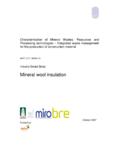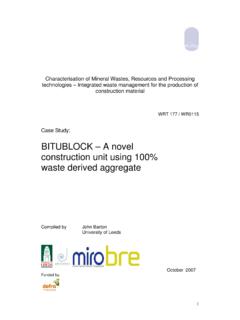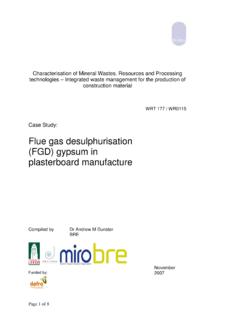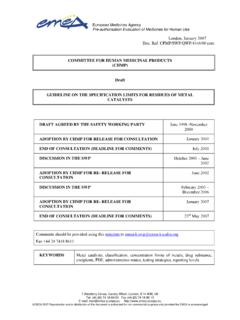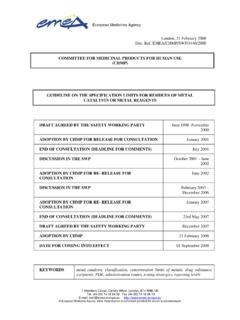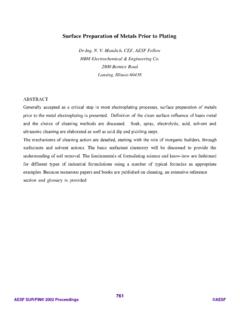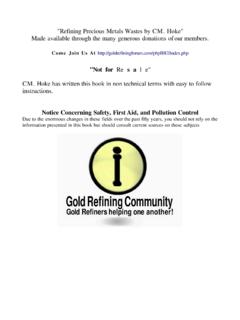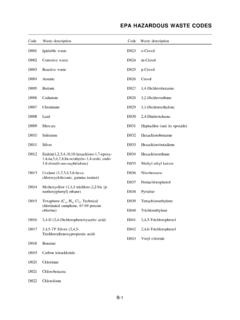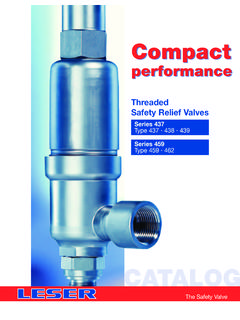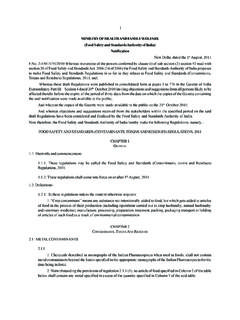Transcription of Cement aluminium dross - SMARTWaste
1 Page 1 of 8 Characterisation of Mineral Wastes, Resources and Processing technologies Integrated waste management for the production of construction material WRT 177 / WR0115 Case Study: Residues from aluminium dross recycling in Cement Compiled by Dr Evaggelia Petavratzi Scott Wilson (formerly of the University of Leeds) Funded by: November 2007 Page 2 of 8 Introduction aluminium dross represents a residue from primary and secondary aluminium production. Drosses are classified according to their metal content into white and black dross . White dross is of higher metal aluminium content and it is produced from primary and secondary aluminium smelters, whereas black dross has a lower metal content and is generated during aluminium recycling (secondary industry sector). White dross may contain from 15 to 70% recoverable metallic aluminium and it comprises a fine powder from skimming the molten aluminium1.
2 Black dross typically contains a mixture of aluminium oxides and slag, with recoverable aluminium content ranging between 12 to 18%, and much higher salt content (typically higher than 40%2) than the white dross1. The non-metallic residues generated from dross smelting operations is often termed salt cake and contains 3 to 5% residual metallic aluminium [1]. Approximately, up to 4 million tonnes of white dross and more than a million tonnes of black dross are reported throughout the world each year, and around 95% of this material is landfilled [2,3]. According to research undertaken during 2002, in the UK, the industry disposes of around 200,000 tonnes of white and black dross [2,3]. The quantities of dross landfilled nowadays are expected to be lower, as part of this material is reprocessed by manufacturing firms such as JBM International Ltd, to recover metal aluminium as well as aluminium oxides.
3 Figure 1: White dross in lump form with high aluminium content Figure 2: White dross with low aluminium content Figure 3: Black dross with high salt Figure 4: Black dross in lumps Page 3 of 8 This case study investigates the use of aluminium oxides generated from dross processing, in Cement . The terms non-metallic residues, aluminium oxides and salt cake are used interchangeably in this case study. Potential applications for white/black dross The composition of aluminium dross is highly variable and usually unique to the plant generating the waste, hence finding potential applications for this material is often seen as a difficult task. However, economically viable recovery processes have now become available and allow part of this material to be recycled. Through this recycling process aluminium metal is recovered and aluminium oxides can find application into powder metallurgical products and construction uses.
4 Research investigated the use of white/black dross in concrete and asphalt products and concluded that there is significant potential for use as a filler (<700 m). Utilization of this material as filler in asphalt may improve stiffness and it is thought that could also improve abrasion resistance and control micro-cracking [4]. The potential use of dross (as filler) in concrete products (such as, non-aerated concrete, concrete bricks and concrete roof tiles) was thought as more likely however, further study is recommended as there is still no proven added value information for this applications [3]. Other references [5,6] are also relevant sources on the recovery and use of aluminium dross and subsequent residues are. aluminium recycling The dross produced by the aluminium industry, although a waste, contains aluminium and other valuable elements ( aluminium oxides), which could be recovered and reused.
5 Conventional methods recycle less than half of all white dross and all black dross is sent to landfill. However, a new method has been developed, currently in use by Jesse Brough Metals Group (JBM International), which could recover 100% of aluminium dross . The processing steps involved are described in Figure 5. aluminium dross initially is milled and screened (sieve aperture ). Material above is fed in the furnace to produce metal aluminium , which is subsequently cast in ingots. The melting process also produces some residual dross of very low grade, which is recycled into the process to recover as much of metal aluminium as possible. The material below mm produced during milling and screening, consists primarily of aluminium oxides with very low metal content .The use of the eddy current separator allows the removal of any residual metal and the beneficiated material is delivered to Plasmet UK Ltd, for further processing.
6 The scope of the activities undertaken by Plasmet is to produce saleable commodities for use in steelworks. aluminium oxides are blended and classified to manufacture a product to specification. JBM International currently produces aluminium oxide mixtures for use in metallurgical applications only, as the utilization of these materials in construction and ceramic products, hence in lower value markets, has not proven profitable. JBM processes at the moment approximately 20,000 tonnes of dross per annum, with a 50/50 cut between the two primary end products namely aluminium metal and aluminium oxides for powder metallurgy products. Around 6000 tonnes per annum are used in metallurgical applications, whereas the remaining 4000 tonnes represent a residue without an end market. Page 4 of 8 aluminium dross (black/white) Milling aluminium oxides metal aluminium Eddy Current Separation (ECS) PLASMET Blending Facility (Include stages of screening, blending, packaging) Furnace aluminium Ingot dross (low grade) Powder metallurgy products End product in Cement pre-mixes Screening (air separation screening) [< , 50% (by weight)] [> , 50% (by weight)] Figure 5: aluminium recycling flowsheet - JBM International Page 5 of 8 Figure 6: The casting process of metal aluminium produced from dross reprocessing Figure 7: aluminium ingots from aluminium dross recycling Benefits and Barriers (extracted from the Waste-Product Pairings database) Non-metallic residues produced during processing of aluminium dross could be used as a source of aluminium oxide in Cement s recipe.
7 Information regarding the referred match on potential benefits, barriers and analysis requirements were extracted from the WPP database and they are presented below. 1. Contribution to the end product. A source of aluminium oxide (Al2O3) 2. Potential benefits: - Material related i. aluminium oxides from dross recycling comprise an alternative source to primary materials - Economic: i. aluminium smelters benefit by charging a gate fee for handling and processing waste dross . ii. The end products of the aluminium recycling process ( aluminium ingots, powder metallurgy products) are considered as high value. - Environmental i. Less waste is disposed of to landfill. 3. Potential barriers: - Material related: i. Both white and black dross may include undesirable compounds such as chlorides, fluorides, heavy metals and metal aluminium , which could adversely influence the composition of feedstock for Cement manufacture.
8 It is common practices to include blending and classification stages for Cement kiln meal constituents to minimise the impact of such contaminants ii. aluminium dross is generated in small volumes and the availability of such materials may reduce further due to the decline of the primary aluminium industry in the UK iii. aluminium dross is generated in small amounts from all around the UK and it needs gathering, hence finding local sources is not always possible. iv. The Cement sector would require a critical mass of suitable aluminium oxide to match end market demand. Page 6 of 8 4. Analysis requirements: Testing is carried out to identify the properties and characteristics of alternative materials and end products, as well as to determine that the inclusion of certain alternative materials provide desirable results during lab-based experimentation.
9 - Testing on alternative materials: particle size analysis, mineralogy, chemistry, total sulphur, chlorine content, heavy metals, loss on ignition - Testing on kiln feed: Al2O3 content (% by mass); MgO content (% by mass) - Testing on end products : in accordance with BS EN 197-1:2000 Residues from aluminium dross in Cement As discussed in the aluminium Recycling section of this case study, only part of the aluminium oxides produced from Plasmet UK Ltd have an end market at the moment with the remaining staying unused. aluminium oxides could be blended together with other waste materials to prepare appropriate premixes for Cement kilns. Feedstock materials used in clinker production consist of four major components lime (CaO), silica (SiO2), alumina (Al2O3) and iron oxide (Fe2O3).
10 Commonly these principal constituents derive from primary materials however alternative materials could also be used to produce suitable feedstock. aluminium oxide is provided to Cement recipe through the inclusion of clay materials. Pre-mixes can be prepared based on the specific needs of each Cement work and appropriate materials are selected according to their properties (physical and chemical). The proposed model provides flexibility to Cement manufacture in acquiring fit-for-purpose feedstock from alternative sources and assists the sector to achieve sustainability targets on the use of alternative materials. The model is also presented in Figure 8. lime silica alumina Iron oxide Processing/blending activities JBM International and Plasmet Cement plant Cement Premixes Alternative materials ( aluminium oxides from dross ) (foundry sand) (paper sludge ash, fly ash) (steel works dust) [Alternative materials consisting of the following components are considered for use] Figure 8: Proposed model regarding the use of alternative material including aluminium oxides from JBM Group for the production of feedstock for clinker production Page 7 of 8 JBM International and Plasmet are looking in implementing the above model, with the objective to utilise aluminium oxides produced from their process together with other alternative materials which will provide the sources for the remaining three components used in Cement kiln meal.


